 Over the years, our staff here at SnoWest Magazine has been asked countless times, "Where's your favorite place to ride?"
Over the years, our staff here at SnoWest Magazine has been asked countless times, "Where's your favorite place to ride?"
And we've given countless answers-answers that sometimes change year to year. There are so many good riding areas in the West that it really is tough to narrow it down to a handful. We have done it but the next time we make a list, it changes. That's because we've discovered new areas and that always has to figure into the mix.
A few things remain constant, though. Those few things are usually the same that any snowmobiler who loves to ride the West would name. Here they are, in no particular order: mountains, deep snow, champagne powder, varied terrain, spectacular scenery, endless off-trail riding.
Every state in the West-from Alaska to New Mexico-offer those elements in excess.
We've written page after page of details about where to ride, how to get information, all those touristy kinds of things. But to really appreciate what snowmobiling is all about in the West, you have to experience it.
There's just something about standing on a mountain ridge and looking for miles in every direction on a bluebird day and seeing nothing but mountains and trees and snow. Or floating in powder so deep that it flows over your hood, forcing you to stand just so you can breathe. Or gaining several hundred-or thousand-feet in a matter of minutes on the back of a snowmobile.
Snowmobiling in the West is like no other. Period.
Here at SnoWest Magazine, we may live in the West, but we never tire of riding the West.
So it's with a lot of pride in what the West has to offer that we present our exclusive Western Guide to Snowmobiling Travel Guide.
Here you'll find the most comprehensive guide to snowmobiling the western United States anywhere.
Alaska
 When some people talk about Alaska, it's just natural to throw a lot of numbers around. You know, like, with 570,951 square miles, Alaska is four times bigger than California. Or Alaska is two times bigger than Texas. Alaska's Mt. McKinley is 20,320 tall, making it the tallest mountain in North America.
When some people talk about Alaska, it's just natural to throw a lot of numbers around. You know, like, with 570,951 square miles, Alaska is four times bigger than California. Or Alaska is two times bigger than Texas. Alaska's Mt. McKinley is 20,320 tall, making it the tallest mountain in North America.
You could go on and on and no doubt those are impressive numbers, but some that really catch our eye are the copious amounts of snow (usually measured in feet, not inches) that falls each winter across Alaska and one more that we just came across-the number of sleds per square mile. Because of Alaska's vast land mass and small population, there are only 1.1 persons per square mile. When it comes to snowmobiles, that number shrinks to just .096 sleds per square mile.
Talk about room to roam. Even when you throw out the places you can't ride, such as Wilderness areas, there's still a lot of Alaska left to discover. And darn near all of it is covered with feet of snow during the winter.
There's a mix of every kind of snowmobiling you can imagine in Alaska. Throw in the fact that the season is very long-sledding starts as early as October and can go well into May, June and even July-and a lack of crowds, and you can see why Alaska is such a coveted snowmobiling spot.
Few places in North America have the mountains and ranges you'll find so far north and so close to the ocean as are found in Alaska. And there aren't many places where you can sled right from sea level (practically from the ocean's edge) and shoot up several thousand feet into the mountains.
There are places in Alaska with small, developed trail systems as well as locations that attract more snowmachiners than others, but it's still pretty wide open with sometimes your only limits being the amount of gas you can carry and your reliance on a GPS.
Some of the more popular local sledding spots include Hatcher Pass, Nancy Lake State Recreation Area/Willow and Big Lake, north of Anchorage, the White Mountains, Summit and Cantwell near Fairbanks, Tok, Delta Junction, Valdez and Eureka. Of course, these riding areas are just a small portion of what is actually available.
Other riding options include selected Alaska state parks, which include the already-mentioned Nancy Lake. A handful of others where snowmachining is allowed include Birch Lake State Recreation Site, Chena River State Recreation Area, Denali State Park and Chugach State Park. For more information on these parks and others, log on to http://dnr.alaska.gov/parks/ and click on the individual parks section. Riding is also popular and allowed in Alaska's two state forests-Tanana Valley (near Fairbanks) and Haines (near Haines).
Contact the Alaska State Snowmobile Association for information on riding in the state by logging on to the ASSA website at www.aksnow.org. The state association's website has good information on several trail systems and what awaits you when you ride there.
Guide
Travel Alaska-www.travelalaska.com
Alaska State Snowmobile Association-www.aksnow.org
Highest Point-Mount McKinley (20,320 ft)
Greatest Average Annual Snowfall-Thompson Pass 551.5 in.
Record Winter Snowfall-Thompson Pass 974.5 in.
Arizona
 If you listened to all the hype and marketing lines about Arizona during the winter months, you'd never know it even snowed in the state.
If you listened to all the hype and marketing lines about Arizona during the winter months, you'd never know it even snowed in the state.
Not only does it snow in the Grand Canyon state's higher elevations, it snows enough that you can enjoy several weeks of snowmobiling during the dead of winter-the same time of year thousands of "snowbirds" flock to the state for its famed sun.
The average snowfall each winter in most areas of Arizona where you can snowmobile is about 100 inches. Of course, snowfall depends on the elevation. For example, Pinetop-Lakeside, one of Arizona's famous mountain retreats, sits at 6,800 feet and gets about 46 inches of snow a winter. Head a bit east and south to Hawley Lake (elevation 8,200 feet) and the snowfall more than triples to 168 inches a winter. Southeast a little more and you find Baldy Peak (11,590 feet) and the snowfall is more than 225 inches a year.
The snow falls on mountains that dissect Arizona from northwest to southeast.
Arizona's snowmobile season isn't as long as in other western locales, but when the snow does fall you can head to the high country and find lots of untracked snow.
There are no groomed trails in the state but there are plenty of old logging roads and forest service roads that crisscross the band of mountains that help form the Mogollon Rim and points northwest. This swath of mountains is about 250 miles or so from one end to the other.
Your best source of information on snowmobiling in Arizona is to go to www.fs.fed.us and navigate to Arizona's national forests and look under the recreation section. The numbers listed in the chart under "Information" are also helpful.
Guide
Arizona Office of Tourism-www.arizonaguide.com
Groomed Trails-None
Highest Point-Humphrey Peak (12,633 ft)
Greatest Average Annual Snowfall-Sunrise Mountain 243 in.
Record Winter Snowfall-Sunrise Mountain 400.9 in.

California
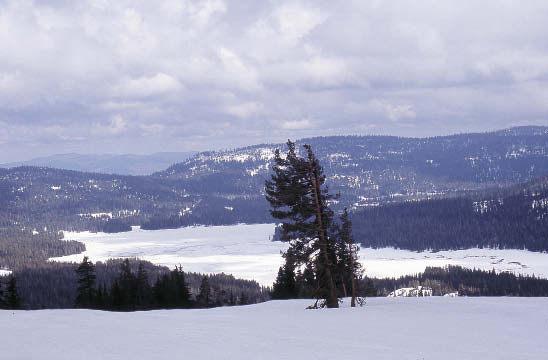 Of all the things California is famous for-and there are a lot of them from Mickey Mouse to sun and surf-you don't hear snowmobiling bandied around very much, if at all.
Of all the things California is famous for-and there are a lot of them from Mickey Mouse to sun and surf-you don't hear snowmobiling bandied around very much, if at all.
Most folks know it snows in parts of California but they're surprised when they hear there are about 2,500 miles of groomed snowmobile trails in well-defined systems up and down the state.
It's just about 650 miles from where you can ride in northern California near the California/Oregon border to the Angeles and Los Padres national forests in the south. While you can't ride from the north to the south non-stop on a snowmobile, there are dozens of riding areas scattered from one end of California to almost the other where you can ride.
Most snowmobiling is on the western slope of the famous Sierra Nevada (which is Spanish for Snowy Range) Range, which has a reputation for its deep snows. Some places in the state can get as much as 40 feet of snow. Even with the popularity of snowmobiling in the Sierra Nevadas, though, you can still find yourself alone in the backcountry if you try hard enough.
 There are swaths of riding areas spread from the northern border with Oregon to the central part of the state and pockets of riding everywhere else. You just have to do a bit of sleuthing to find them and then enjoy them. We've listed the most popular and best developed areas in this section. For example, we've listed the snowmobile area of Siskiyou County, home to 14,162-foot Mt. Shasta, but head to the Modoc National Forest website and you'll read about the Medicine Lake Highlands, which offer 31 miles of groomed trails and the Doorknob Snowmobile Park. That seems to be a somewhat common theme in California-well-developed trail systems with a smaller riding area nearby.
There are swaths of riding areas spread from the northern border with Oregon to the central part of the state and pockets of riding everywhere else. You just have to do a bit of sleuthing to find them and then enjoy them. We've listed the most popular and best developed areas in this section. For example, we've listed the snowmobile area of Siskiyou County, home to 14,162-foot Mt. Shasta, but head to the Modoc National Forest website and you'll read about the Medicine Lake Highlands, which offer 31 miles of groomed trails and the Doorknob Snowmobile Park. That seems to be a somewhat common theme in California-well-developed trail systems with a smaller riding area nearby.
A good website to check out for snowmobiling is the California OHV site- http://ohv.parks.ca.gov-which gives information on the sno-parks.
In listing the primary snowmobiling areas in California, we chose to list the name of the trailhead that serves the trail system or use the county in which the trailheads are located for easier referencing when trying to locate each area.
Guide
California Tourism-www.visitcalifornia.com
California-Nevada Snowmobile Association-www.cnsa.net
Groomed Trails-2,500 miles
Highest Point-Mount Whitney (14,494 ft)
Greatest Average Annual Snowfall-Soda Springs 470.7 in.
Record Winter Snowfall-Tamarack 884 in.
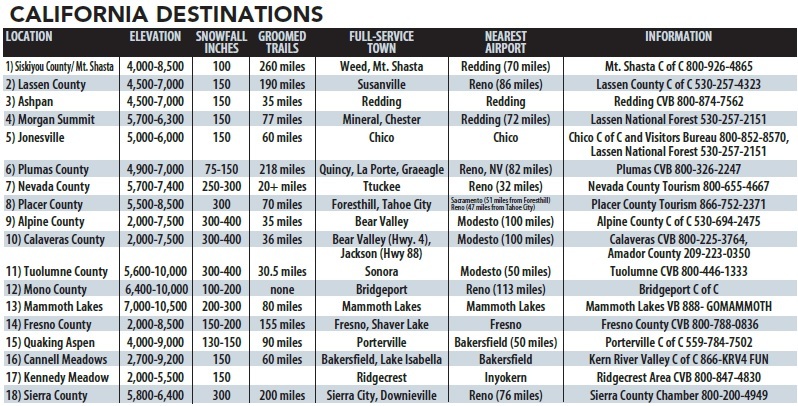
Colorado
 How could you go wrong if you were to snowmobile in Colorado?
How could you go wrong if you were to snowmobile in Colorado?
You can't.
Except for the farthest one-quarter expanse on Colorado's eastern border, the state is just about wall-to-wall mountains. And that helps it earn the unique characteristic of having the highest average elevation-6,800 feet-of any state in America.
Snowmobiling usually starts at around 7,000 feet and just goes up from there. We've snowmobiled to 12,000 feet on several occasions.
 Those lofty heights come courtesy of the rugged Rocky Mountains that make up the mountain ranges in Colorado, which is home to more Fourteeners than any other state in the West. Fourteeners are mountains which are 14,000 feet or higher. And Colorado has 58 mountain peaks that stretch more than 14,000 feet into the sky, led by Mt. Elbert at 14,433 feet.
Those lofty heights come courtesy of the rugged Rocky Mountains that make up the mountain ranges in Colorado, which is home to more Fourteeners than any other state in the West. Fourteeners are mountains which are 14,000 feet or higher. And Colorado has 58 mountain peaks that stretch more than 14,000 feet into the sky, led by Mt. Elbert at 14,433 feet.
Guide
Colorado Travel-www.colorado.com
Colorado Snowmobile Association-www.coloradosledcity.com
Groomed Trails-2,600 miles
Highest Point-Mount Elbert (14,433 ft)
Greatest Average Annual Snowfall-Wolf Creek 434.8 in.
Record Winter Snowfall-Wolf Creek Pass 807 in.
Popular Services
Grand Mesa Lodge-(800) 551-6372
Rocky Mountain Lodge-(303) 289-1034
Spirit Lake Lodge-(970) 627-3344
Steamboat Lake Outfitters-(970) 879-4404
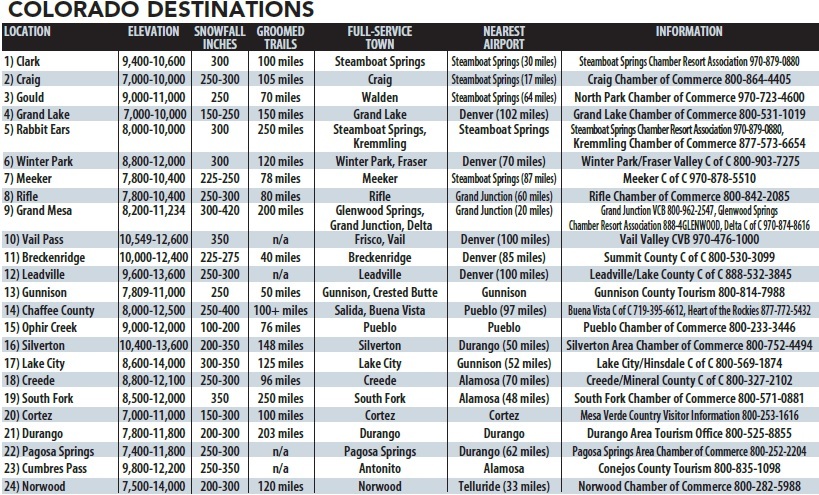
Idaho
 We made a discovery about Idaho nearly a year ago that should excite just about any snowmobiler who likes to ride the West.
We made a discovery about Idaho nearly a year ago that should excite just about any snowmobiler who likes to ride the West.
Regardless of where you are in Idaho, you're only about an hour's drive from the mountains. Yea, those mountains are just about everywhere you turn.
 And that means there is great snowmobiling in the Gem State. Throw in more than 5,500 miles of groomed trails and you'll really get snowmobilers all excited.
And that means there is great snowmobiling in the Gem State. Throw in more than 5,500 miles of groomed trails and you'll really get snowmobilers all excited.
With at least 28 separate and distinct riding areas with just groomed trail systems-and probably a dozen  more without groomed trails-Idaho has something for every snowmobiling taste.
more without groomed trails-Idaho has something for every snowmobiling taste.
The riding elevations range between 1,000-10,000 feet. The lower elevations are mostly in northern Idaho with the taller ranges farther south and along the Continental Divide that marks the boundary between Idaho and Montana. Those 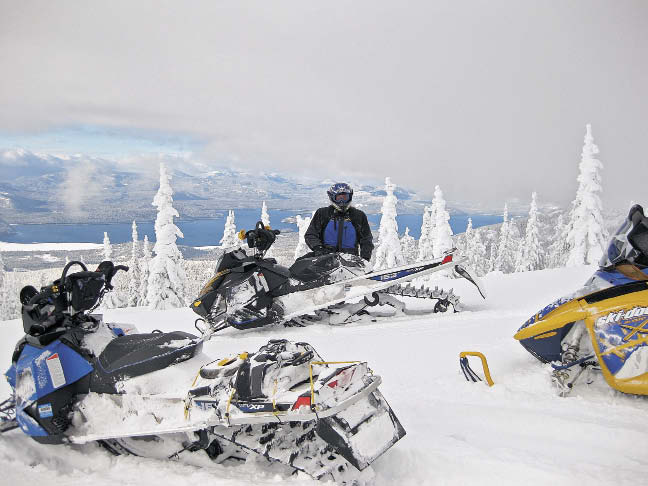 1,000-5,000 foot elevations can be every bit as challenging as the areas which hit 8,000-9,000 foot and higher.
1,000-5,000 foot elevations can be every bit as challenging as the areas which hit 8,000-9,000 foot and higher.
A good source of information on snowmobiling in the state is www.idahowinter.org.
Guide
Idaho Travel Council-www.visitid.org
Idaho State Snowmobile Association-www.idahosnowbiz.com
Groomed Trails-5,600 miles
Highest Point-Borah Peak (12,662 ft)
Greatest Average Annual Snowfall-Mullan Pass 283.5 in.
Record Winter Snowfall-Roland West Portal 441.8 in.
Popular Services
Mack's Inn Resort-(208) 558-7272
Mountain Village Resort-(208) 774-3661

Montana
 Montana is home to some of the most famous and most popular snowmobiling spots not on in the West but in the entire snowbelt.
Montana is home to some of the most famous and most popular snowmobiling spots not on in the West but in the entire snowbelt.
There's Seeley Lake, West Yellowstone, the Flathead Valley, Cooke City, just to name a few.
For every one of those well-known snowmobiling spots in Montana, there's another half-dozen lesser known but every-bit-as-good riding places that sledders enjoy every winter.
 There is range after range of mountains in the western third of the state, dominated by the Continental Divide/Rocky Mountains that separate Montana from its western neighbor, Idaho.
There is range after range of mountains in the western third of the state, dominated by the Continental Divide/Rocky Mountains that separate Montana from its western neighbor, Idaho.
Montana has two dozen well-defined riding areas where trails are groomed-3,500 miles in all-but that doesn't include all the backcountry areas where there is no grooming. Riding in Montana will take you past places rich in history, mining towns, awesome scenery, spectacular mountain ranges, scenic lakes and rivers, pristine backcountry areas and impeccable trails.
Montana does a good job of promoting snowmobiling and other winter sports. In addition to the state's tourism website (www.visitmt.com), try www.wintermt.com.
Guide
Travel Montana-www.visitmt.com
Montana Snowmobile Association-www.snowtana.com
Groomed Trails-3,500
Highest Point-Granite Peak (12,799 ft)
Greatest Average Annual Snowfall-Kings Hill 305.5 in.
Record Winter Snowfall-Kings Hill 426.0 in.
Popular Services
Big Moose Resort-(406) 838-2393
Comfort Inn-(406) 646-4212
Kelly Inn-(406) 646-4544
Yellowstone Adventures-(406) 646-7735
Yellowstone Townhouses-(406) 646-9331

Nevada
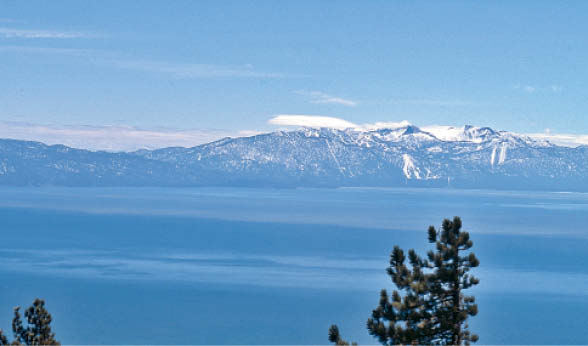 There are only three states in the West that don't have an extensive groomed snowmobile trail system and Nevada is one of them.
There are only three states in the West that don't have an extensive groomed snowmobile trail system and Nevada is one of them.
That causes some sledders to look elsewhere for their winter fun.
Big mistake.
Yea, there's no big trail system in Nevada but there is plenty of snow and wide open country that does attract those snowmobilers looking to get away from the crowds.
Nevada-or at least part of it-has long been famous for winter sports, particularly around Lake Tahoe. However, there is plenty of snowfall across other parts of the state, especially in the mountains that are spread across the northern sections. According to the government, Nevada is the most mountainous state in the country, with more than 300 individual mountain ranges and 42 named summits over 11,000 feet.
Snows are wet, dense and deep as they enter Nevada-which means snow laden or snow covered in Spanish-on the Sierra Nevada side around Lake Tahoe, but dry out as they cross the state.
There is a handful of riding areas in Nevada, from the far west around Lake Tahoe to the eastern part of the state near Elko in the Ruby Mountains as well as nearby Mountain City. North of Winnemucca are the Santa Rosa Mountains where you can sled at the higher elevations. You can ride south of Elko, near Ely. Between Reno and Ely is the Toiyabe Range, near Austin, where there is also some snowmobiling.
The key to snowmobiling in Nevada is to do your homework before you leave home. You can use the cheat sheet we started for you in the accompanying chart.
Guide
Nevada Commission on Tourism-www.travelnevada.com
California-Nevada Snowmobile Association-www.cnsa.net
Groomed Trails-None
Highest Point-Boundary Peak (13,140 ft)
Greatest Average Annual Snowfall-Daggett Pass 123.1 in.
Record Winter Snowfall-Mt. Rose Resort 323 inches

New Mexico
 When people hear the words "Rocky Mountains," they usually think of Colorado or maybe Wyoming, Idaho or Montana.
When people hear the words "Rocky Mountains," they usually think of Colorado or maybe Wyoming, Idaho or Montana.
But we say give credit where credit is due. New Mexico should come to mind, as well. After all, the Rocky Mountains enter the United States in New Mexico. The Continental Divide, the backbone of the Rockies, makes quite a journey through New Mexico as it winds its way from Mexico in the south to Colorado in the north. Generally speaking, the Divide stays mostly in the western part of the state.
New Mexico has six peaks rising higher than 13,000 feet and 38 peaks reaching past 12,000 feet, most all of which are part of the Continental Divide. However, those aren't the only mountains in New Mexico and thus, not the only places to snowmobile.
There is a small range in the central part of the state between Alamogordo and Roswell as well as numerous mountains up north, where most of the state's downhill ski areas are.
There are a half-dozen fairly defined riding areas in the state, stretching from near the bottom portion of New Mexico near Cloudcroft north to the New Mexico/Colorado border.
The major riding areas in this state of Enchantment are (from north to south): Chama, Red River, Angel Fire, Mt. Taylor, San Pedro Mountains, Jemez Mountains and Cloudcroft.
Guide
New Mexico Department of Tourism-www.newmexico.org
Groomed Trails-100
Highest Point-Wheeler Peak (13,161 ft)
Greatest Average Annual Snowfall-Bateman Ranch 147.0 in.
Record Winter Snowfall-Anchor Mine 483 in.

Oregon
 Not only does Oregon offer all kinds of snowmobiling opportunities across the vast state, it has different kinds of snow, too.
Not only does Oregon offer all kinds of snowmobiling opportunities across the vast state, it has different kinds of snow, too.
Snow is not just snow in Oregon. As storms roll off the Pacific Ocean, they are dripping with moisture, which translates into wet, heavy snow in most parts of the Cascade Mountains, the first major mountain range those storms hit as they march westward.
As those same storms continue their westward trek, they "dry" out a bit and you end up with dry, light powder farther inland.
 Whether it's wet and heavy or dry and light snow, a bunch of it falls in Oregon. Storms dump up to 500 inches of snow every winter on Crater Lake National Park. While Crater Lake gets most of the snowfall headlines in the state, move up the Cascade Range to Government Camp and you'll see that area gets an average of 275 inches of snow every winter. Varying amounts fall all across the Cascades, making for great riding just about anywhere.
Whether it's wet and heavy or dry and light snow, a bunch of it falls in Oregon. Storms dump up to 500 inches of snow every winter on Crater Lake National Park. While Crater Lake gets most of the snowfall headlines in the state, move up the Cascade Range to Government Camp and you'll see that area gets an average of 275 inches of snow every winter. Varying amounts fall all across the Cascades, making for great riding just about anywhere.
Even farther west, 100-200 inches of snow falls every winter, depending on where you're riding.
The Oregon State Snowmobile Association has gone to a lot of work to get its trail maps onto its website (www.oregonsnow.org) and going there will provide you with needed information before heading out to ride. Each map details where trailheads and parking areas are, as well as key highways to access the riding areas.
Guide
Oregon Tourism Commission-www.traveloregon.com
Oregon State Snowmobile Association-www.oregonsnow.org
Groomed Trails-6,410
Highest Point-Mount Hood (11,239 ft)
Greatest Average Annual Snowfall-Crater Lake 529.9 in.
Record Winter Snowfall-Crater Lake 835.5 in.
Popular Services
Diamond Lake Resort-(541) 793-3333
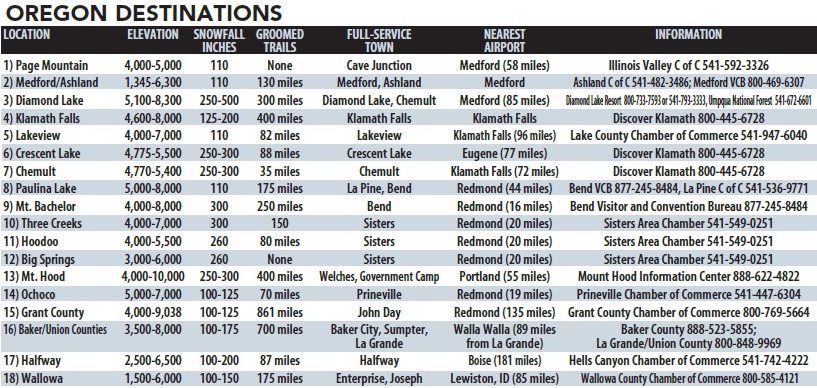
Utah
 You may or may not agree with Utah's claim of "The Greatest Snow On Earth."
You may or may not agree with Utah's claim of "The Greatest Snow On Earth."
But it sure is fun to try and prove that claim one way or the other. Mother Nature does her part to back the claim with plenty of snow in most mountainous areas of the state during the winter months and the humans are doing their part with the creation of a modest size trail system that covers the major riding areas in the state.
Utah's snowbelt stretches from the Utah/Idaho border in the north nearly all the way (within 40 miles) to the Arizona/Utah border in the south. Most mountain ranges run north and south 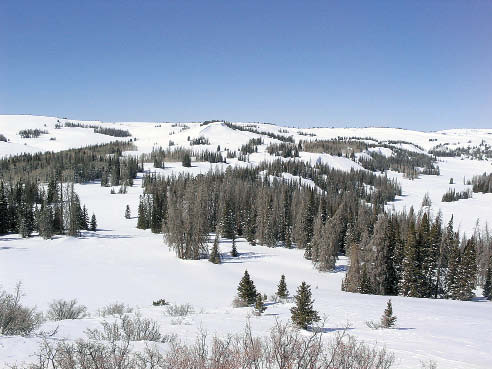 through Utah and can be accessed by nearly 1,200 miles of state-groomed trails. Riding starts out at about 6,000 feet and tops out between 12,000-13,000 feet.
through Utah and can be accessed by nearly 1,200 miles of state-groomed trails. Riding starts out at about 6,000 feet and tops out between 12,000-13,000 feet.
Utah calls its riding areas complexes and there are nine separate systems to explore in the state, including (starting in the north): Hardware Ranch/Monte Cristo/Logan Canyon or Cache Valley; Mirror Lake/Currant Creek; Uinta Basin; Wasatch Mountain State Park; Strawberry; Skyline Drive; Ephraim/Manti/Joe's Valley/Ferron; Fishlake; and Cedar Mountain/East Fork (also known as Duck Creek).
Guide
Utah Travel Council-www.Utah.com
Utah Snowmobile Association-www.snowut.com
Groomed Trails-1,200 miles
Highest Point-Kings Peak (13,528 ft)
Greatest Average Annual Snowfall-Alta 516.3 in.
Record Winter Snowfall-Alta 846.8 in.
Popular Services
Bear Lake CVB-(435) 946-2197
Preston Harward-(435) 896-6264

Cedar Breaks National Monument
 Cedar Breaks National Monument is small-just 6,154 acres-but the scenery is huge. Cedar Breaks is famous for its massive natural amphitheater which extends 2,000 feet deep and more than three miles in diameter. The park is located in Southern Utah and sits on the 10,000-foot high Markagunt Plateau. Deep in the bowels of the amphitheater are spires, columns, arches and pinnacles, all decked out in beautiful colors.
Cedar Breaks National Monument is small-just 6,154 acres-but the scenery is huge. Cedar Breaks is famous for its massive natural amphitheater which extends 2,000 feet deep and more than three miles in diameter. The park is located in Southern Utah and sits on the 10,000-foot high Markagunt Plateau. Deep in the bowels of the amphitheater are spires, columns, arches and pinnacles, all decked out in beautiful colors.
There is one trail available for snowmobilers and it's six miles from one end of Cedar Breaks to the other. The ungroomed snowmobile trail follows Highways 148 and 143 through the monument. On the way through the monument, you can stop and see Point Supreme (10,350 feet), where you can get spectacular views of the amphitheater as you are standing on the very edge of the cliff. There are also two other viewpoints where you can see the amphitheater from a different angle. Remember, stay on the trail. No off-trail riding is allowed.
For more information, contact Cedar Breaks National Monument (435) 586-9451.
Washington
 Mt. Rainier. Mt. Adams. Mt. St. Helens. Mt. Baker. The Blues.
Mt. Rainier. Mt. Adams. Mt. St. Helens. Mt. Baker. The Blues.
Those are Washington state's real skyscrapers. They are impressive towers of granite for sure. They dominate the landscape in their respective parts of Washington and probably no more so than during the winter months when those mountains are buried deep with snow.
With very few exceptions, you can't even ride on those mountains we just mentioned but you can get close enough that you're just about riding in their shadows and if you've experienced that, you'll agree it's pretty awesome.
While those mountains seem to get all the attention in Washington, there are plenty of other peaks and ranges that snowmobilers enjoy all across the state. And those places are covered with  a thick blanket of snow that falls from moist Pacific storms that hammer Washington during the winter months.
a thick blanket of snow that falls from moist Pacific storms that hammer Washington during the winter months.
Need proof? Seven of the top 14 spots in the United States with more than 400 inches of snow a year can be found within the borders of the Evergreen State. Rainier Paradise Ranger Station leads the way with 674.2 inches of snow each year, followed by Stevens Pass (493.2 inches), Santiam Pass (453.3), Snoqualmie Pass (439.9) and Stampede Pass (438.7). Do the math and that's between 36 to 56 feet of snow.
A good source of information for riding in Washington state is on the state's parks website, www.parks.wa.gov/winter, and then navigate to the sno-parks section where you'll find trail maps.
Guide
Washington State Tourism-www.tourism.wa.gov
Washington State Snowmobile Association-www.wssa.us
Groomed Trails-3,000
Highest Point-Mount Rainier (14,411 ft)
Greatest Average Annual Snowfall-Rainier Ranger Station 674.2 in.
Record Winter Snowfall-Mt. Baker 1,140 in.
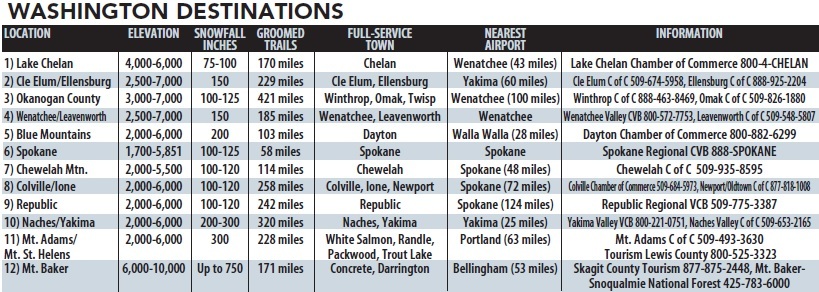
Wyoming
 The number of snowmobiling areas-four (including three of the Top 5)-that made SnoWest Magazine's Top 15 Trails in the West annual survey is a good indication of how good the snowmobiling is in Wyoming.
The number of snowmobiling areas-four (including three of the Top 5)-that made SnoWest Magazine's Top 15 Trails in the West annual survey is a good indication of how good the snowmobiling is in Wyoming.
Those areas-the Snowy Range, Alpine, the Big Horns and the Continental Divide Snowmobile Trail-represent most areas of the state which shows one area of the Cowboy State doesn't really overshadow any of the other areas. The snowmobiling is good all over the state.
Wyoming is just behind Colorado (No. 1) when it comes to states with the highest mean elevation 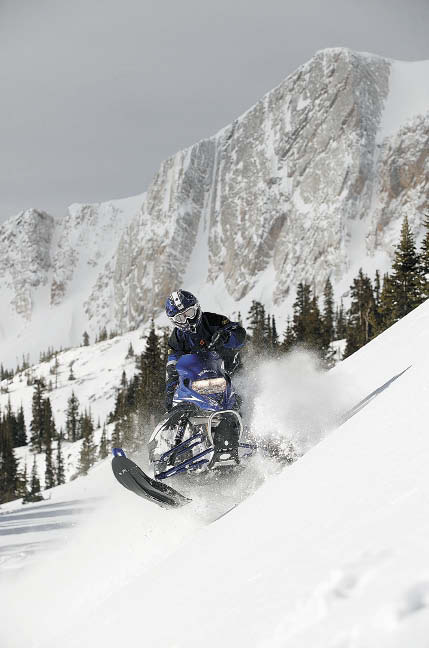 in the United States. And elevation is what riding in the West is all about, so you can be sure you won't be disappointed when it comes to snowmobiling in Wyoming.
in the United States. And elevation is what riding in the West is all about, so you can be sure you won't be disappointed when it comes to snowmobiling in Wyoming.
One of the attractions of snowmobiling in Wyoming-besides the light, dry powder and varied terrain-is the length of the season, which comes courtesy of the state's higher average elevations. In some areas you can begin riding around Thanksgiving time and not have to put the sled away until May or even June.
Then there's Yellowstone and Grand Teton National Parks where, yes, you can still snowmobile. In Yellowstone all snowmobiles are commercially guided and are required to meet NPS best available technology requirements.
For more information, check out www.gosledwyoming.com.
Guide
Wyoming Travel Commission-www.wyomingtourism.org
Wyoming Snowmobile Association-www.snowmobilewyoming.org
Groomed Trails-2,300
Highest Point-Gannett Peak (13,804 ft)
Greatest Average Annual Snowfall-Snake River 270.1 in.
Record Winter Snowfall-Bechler River 491.6 in.

Latest On Snowmobiling In Yellowstone National Park
 The following is the latest information available on snowmobiling in Yellowstone National Park as of this fall.
The following is the latest information available on snowmobiling in Yellowstone National Park as of this fall.
Secretary of the Interior Ken Salazar announced this summer that the National Park Service would reopen public comment on a proposed interim rule, first proposed last November under Secretary Dirk Kempthorne, to manage snowmobile and snowcoach access at Yellowstone National Park for the next two years.
If finalized, the interim rule would allow up to 318 snowmobiles in the park each day for the next two winters. During this two-year period, the National Park Service will develop a new long-term winter use plan for the park. The average snowmobile use in the park over the last three winters has been less than 300 per day.
The proposed rule would replace the 2004 rule reinstated last fall by the U.S. District Court for the District of Wyoming, which governed snowmobile and snowcoach access in the parks for the 2008-2009 winter season.
The interim proposed rule would allow up to 318 commercially guided, Best Available Technology snowmobiles and up to 78 commercially guided snowcoaches per day in Yellowstone, through the 2010-2011 winter season. It would also govern long-term snowmobile access in Grand Teton and the John D. Rockefeller, Jr. Memorial Parkway, including access along Grassy Lake Road, and on Jackson Lake for licensed anglers.
On Nov. 7, 2008, the U.S. District Court for the District of Wyoming issued an order directing the National Park Service to reinstate the 2004 rule for snowmobile and snowcoach use in Yellowstone and Grand Teton National Parks and the John D. Rockefeller, Jr. Memorial Parkway. This rule allows up to 720 BAT, guided snowmobiles into Yellowstone, and up to 78 snowcoaches per day.
However, this fall, that same federal district court judge said he would not block the National Park Service's plans to cut the number of snowmobiles allowed in Yellowstone this winter.
So the good news is, you can ride in Yellowstone National Park this winter on a BAT snowmobile as part of a guided tour. What the future hold, though, is still kind of murky as this whole thing plays out.
The latest information on snowmobiling in these two national parks is available at www.nps.gov/yell.
South Dakota
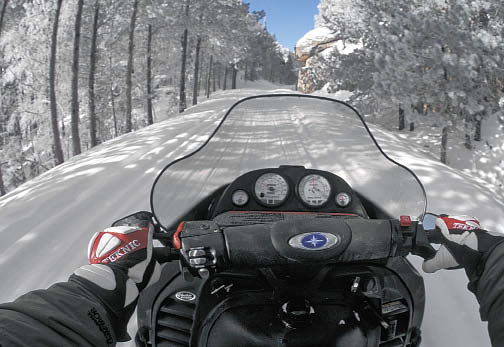 South Dakota may not be able to claim the biggest mountains in the West, but to someone who has been driving over the pancake-flat Great Plains from the Midwest and then see the Black Hills begin to rise off the prairie floor, they're plenty impressive.
South Dakota may not be able to claim the biggest mountains in the West, but to someone who has been driving over the pancake-flat Great Plains from the Midwest and then see the Black Hills begin to rise off the prairie floor, they're plenty impressive.
The Black Hills are the first real mountains (and the only mountain range in South Dakota) sledders from the Midwest see when they head west to ride. While mostly in western South Dakota, the Black Hills do spill over into eastern Wyoming.
Having terrain that changes more than a few hundred feet is one of the reasons the Black Hills are so popular as a winter destination, especially among snowmobilers. Elevations are moderate, from 3,200 feet to 7,000 feet.
Other sled-attraction features include impeccable trails, decent snow and a history-laden past.
The vast majority of trail mileage is in South Dakota, but part of the system also includes parts of eastern Wyoming. In all, there are 350 miles of groomed trails and numerous more ungroomed paths that can keep you busy for several days.
The extensive trail system can be accessed from numerous parking areas spread out over South Dakota and Wyoming. Trails stretch from Lead, Deadwood and just south of Spearfish in the north to near the Crazy Horse Memorial and Custer State Park in the south and from near Galena in the east to close to Buckhorn in eastern Wyoming. All riding is on the 1.2 million-acre Black Hills National Forest. There are several places to bail off the trails into powder-filled meadows.
Those elevations are plenty big, though, to have plenty of fun.
Guide
South Dakota Tourism-www.travelsd.com
South Dakota Game, Fish and Parks-605-773-3391
South Dakota Snowmobile Association-www.itctel.com/sdsa
Groomed Trails-1,613
Highest Point-Harney Peak (7,242 ft)
Record Winter Snowfall-Lead 324 in.
